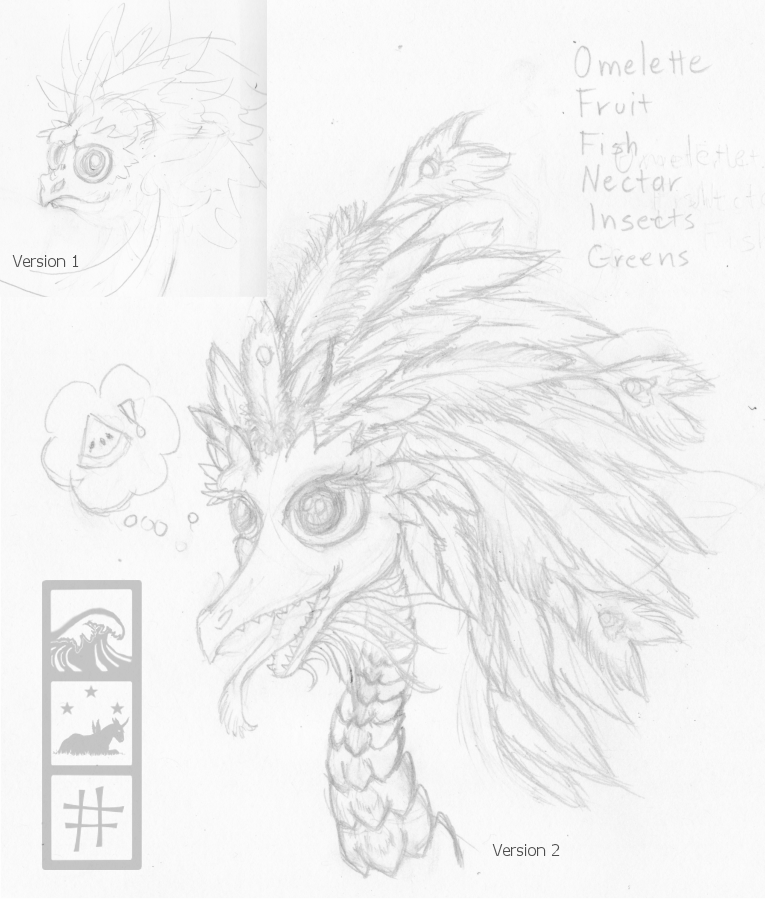
Lily the "Aitvaras". Inspiration to developement to final(?)
An aitvaras is a type of "house spirit" from Lithuanian mythology. Indoors it normally takes the form of a rooster with a fiery tail, an outdoors the form of a dragon. Which is why the aitvaras in title in in quotes. While this little creature got her spark from the legend, she doesn't much resemble the traditional one. Instead she's a tiny dragon species whose features are somewhere between the dragon and the bird. The only thing she retains in the love of omelets and a habit of stealing and hoarding small shiny objects. Isn't that a dragon thing in general though? Bigger dragons just take bigger shinies.
Another aspect of inspiration was one night as a was pushing my cart past the archaeology department's display, I noticed a tiny new bizarre skull had been added to the contents. It had huge eye sockets, each larger than its brain case. I initially though it some kind of strange short-beaked, wide mouthed bird. That was pretty strange itself, since all the other skulls on display were from primates--apes, monkeys, lemurs and and of course various replicas of the more important hominid fossils. So I stepped closer and realized, nope this little critter had teeth. Not a bird.
I had no idea what it was, but a quick google of "mammal skull eyes larger than brain" led me to the tarsier, and sure enough a quick flip though the images of their skull confirmed it.
I knew what body type I wanted Lily to have (long and serpentine) with short limbs and small powerful claws, and feathered wings, tail and crest. No horns. I hadn't (and still haven't) decided whether or not I wanted spikes on the mid-back. I knew she was venomous--a purely defensive venom, since after all small dragons are perfectly edible to large predatory birds and mongooses and killable to mean-spirited people. Most other animals leave them alone, as they're not agile enough to take an aitvaras without being bitten. The venom is non-lethal for larger animals but very unpleasant. It paralyzes and puts one in an altered state of consciousness marked by extreme terror (Imagine the worst case of sleep paralysis ever.) which depending on the intensity of the bite may last ten minutes or a few hours.
I hadn't however, decided on her face. I wanted her to be cute, yet somewhat unsettling and uncanny. I felt the tarsier fit that bill. Version 1 is much more similar to the actual tarsier's facial structure. Version 2 however has more of the prettiness I wanted. I'll probably refine it some more in later version.
You can see Lily's diet to the right in the sketch. Omelets obviously are not a "natural" food. Aitvaras are often kept as "pet" by the peoples of this world--with the understanding that this a "pet" with a level of understanding comparable (as well as the passion, both good and bad) of a child. The wild aitvaras meanwhile takes their eggs raw when they can get them. The "greens" are also mostly a "pet" diet item. In the wild, aitvaras get their "greens" from the gut contents of insects they eat; however "pet" aitvaras, having been spoiled by their "masters" generally don't eat many bugs and usually need to be supplemented.
Lily is young and still relatively small and is a little under two feet long. She is a pearly white, pink and gold/yellow "Lady Velane", a breed noted for it's bright colors, small size and friendly natures.
Aitvaras size varies based on gender, subspecies and "breed" as well. The largest aitvaras is a solitary desert species that may reach as long as six feet. However, this subspecies is also the least colorful and is aggressive and difficult to manage even when hand-reared. Some people do use them for breeding though, usually crossing them with the small friendly bright varieties to try a get a bigger animal with better color and temperament.
...we should mention that this is a bit of a crapshoot, and very often doesn't work. Usually G2 is still a big grey or tan individual with a few bright feathers, or a bit of sheen, who is still irritable and bitey. Cross this animal back again to Lady Velane or similar type may produce a more desirable G3 or G4. However, this requires the keeping of several full-blood and part blood "haggards" who may bite the hand that feeds them or may all fly away and return to the wild...that also live for up to 1000 years. It has it devotees but overall is not a popular pursuit in the aitvaras breeding world.
The dream of the big, colorful, manageable aitvaras is mainly that of people looking for a hunting companion or a potential war animal or sometimes just a big scary status symbol. Almost everyone else prefers the Lilies of the aitvaras world--small, friendly snugglebuddies who chatter or sing and eat from your hands that probably won't bite you or a guest.
In regards to chattering, they can learn to speak. Hand-reared females are usually the best, capable of learning and understanding many words, some degree of syntax and inflection. Males meanwhile make better singers and often only know meaningful words like "hungry" or "fish" though it's been debated as to whether this is due to a lack of ability or a simple lack of interest in non-aitvaras companions. Even in the friendliest breeds, males tend to be aloof. They usually only like one person, if they like people at all. As such, many breeders make a point to scry new eggs at the earliest opportunity and a shocking number of eggs containing males seem to get stolen by mongooses while their very trusting mothers step out for a snack or to relieve themselves. Male eggs of the domesticated aitvaras generally only hatch when the breeder is looking for a new stud. Females normally lay a new egg a short time after the first one is "stolen".
In the wild, the small and medium subspecies live in social colonies, while the larger mountain aitvaras lives in pairs, and the largest desert aitvaras are solitary. Aitvaras are generally well liked by the peoples of the world, though fruit farmers consider them pests and must go to great lengths to protect their crops from these clever thieves. Colonies are noisy and though the aitvaras is a fastidious beast, homes in a colony's flight path may find themselves frequently decorated by droppings, which are sticky, destructive to some surfaces and hard to clean. Tame aitvaras therefore are usually trained to use as specific spot for their toilet for this reason.
...and I think that's enough for now.
...also I realize if I ever color this I'll need to make it a "dim light" pic or else it will be a "flash photo". Those pupils would be quite small in bright light. She keeps that from the real tarsier as well.
Another aspect of inspiration was one night as a was pushing my cart past the archaeology department's display, I noticed a tiny new bizarre skull had been added to the contents. It had huge eye sockets, each larger than its brain case. I initially though it some kind of strange short-beaked, wide mouthed bird. That was pretty strange itself, since all the other skulls on display were from primates--apes, monkeys, lemurs and and of course various replicas of the more important hominid fossils. So I stepped closer and realized, nope this little critter had teeth. Not a bird.
I had no idea what it was, but a quick google of "mammal skull eyes larger than brain" led me to the tarsier, and sure enough a quick flip though the images of their skull confirmed it.
I knew what body type I wanted Lily to have (long and serpentine) with short limbs and small powerful claws, and feathered wings, tail and crest. No horns. I hadn't (and still haven't) decided whether or not I wanted spikes on the mid-back. I knew she was venomous--a purely defensive venom, since after all small dragons are perfectly edible to large predatory birds and mongooses and killable to mean-spirited people. Most other animals leave them alone, as they're not agile enough to take an aitvaras without being bitten. The venom is non-lethal for larger animals but very unpleasant. It paralyzes and puts one in an altered state of consciousness marked by extreme terror (Imagine the worst case of sleep paralysis ever.) which depending on the intensity of the bite may last ten minutes or a few hours.
I hadn't however, decided on her face. I wanted her to be cute, yet somewhat unsettling and uncanny. I felt the tarsier fit that bill. Version 1 is much more similar to the actual tarsier's facial structure. Version 2 however has more of the prettiness I wanted. I'll probably refine it some more in later version.
You can see Lily's diet to the right in the sketch. Omelets obviously are not a "natural" food. Aitvaras are often kept as "pet" by the peoples of this world--with the understanding that this a "pet" with a level of understanding comparable (as well as the passion, both good and bad) of a child. The wild aitvaras meanwhile takes their eggs raw when they can get them. The "greens" are also mostly a "pet" diet item. In the wild, aitvaras get their "greens" from the gut contents of insects they eat; however "pet" aitvaras, having been spoiled by their "masters" generally don't eat many bugs and usually need to be supplemented.
Lily is young and still relatively small and is a little under two feet long. She is a pearly white, pink and gold/yellow "Lady Velane", a breed noted for it's bright colors, small size and friendly natures.
Aitvaras size varies based on gender, subspecies and "breed" as well. The largest aitvaras is a solitary desert species that may reach as long as six feet. However, this subspecies is also the least colorful and is aggressive and difficult to manage even when hand-reared. Some people do use them for breeding though, usually crossing them with the small friendly bright varieties to try a get a bigger animal with better color and temperament.
...we should mention that this is a bit of a crapshoot, and very often doesn't work. Usually G2 is still a big grey or tan individual with a few bright feathers, or a bit of sheen, who is still irritable and bitey. Cross this animal back again to Lady Velane or similar type may produce a more desirable G3 or G4. However, this requires the keeping of several full-blood and part blood "haggards" who may bite the hand that feeds them or may all fly away and return to the wild...that also live for up to 1000 years. It has it devotees but overall is not a popular pursuit in the aitvaras breeding world.
The dream of the big, colorful, manageable aitvaras is mainly that of people looking for a hunting companion or a potential war animal or sometimes just a big scary status symbol. Almost everyone else prefers the Lilies of the aitvaras world--small, friendly snugglebuddies who chatter or sing and eat from your hands that probably won't bite you or a guest.
In regards to chattering, they can learn to speak. Hand-reared females are usually the best, capable of learning and understanding many words, some degree of syntax and inflection. Males meanwhile make better singers and often only know meaningful words like "hungry" or "fish" though it's been debated as to whether this is due to a lack of ability or a simple lack of interest in non-aitvaras companions. Even in the friendliest breeds, males tend to be aloof. They usually only like one person, if they like people at all. As such, many breeders make a point to scry new eggs at the earliest opportunity and a shocking number of eggs containing males seem to get stolen by mongooses while their very trusting mothers step out for a snack or to relieve themselves. Male eggs of the domesticated aitvaras generally only hatch when the breeder is looking for a new stud. Females normally lay a new egg a short time after the first one is "stolen".
In the wild, the small and medium subspecies live in social colonies, while the larger mountain aitvaras lives in pairs, and the largest desert aitvaras are solitary. Aitvaras are generally well liked by the peoples of the world, though fruit farmers consider them pests and must go to great lengths to protect their crops from these clever thieves. Colonies are noisy and though the aitvaras is a fastidious beast, homes in a colony's flight path may find themselves frequently decorated by droppings, which are sticky, destructive to some surfaces and hard to clean. Tame aitvaras therefore are usually trained to use as specific spot for their toilet for this reason.
...and I think that's enough for now.
...also I realize if I ever color this I'll need to make it a "dim light" pic or else it will be a "flash photo". Those pupils would be quite small in bright light. She keeps that from the real tarsier as well.
Category All / All
Species Dragon (Other)
Gender Female
Size 765 x 900px
File Size 571.5 kB

 FA+
FA+

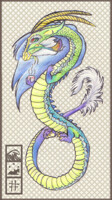

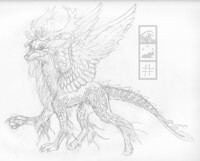
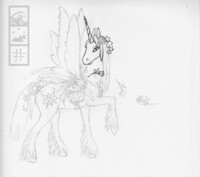
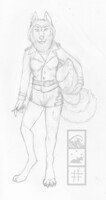

Comments